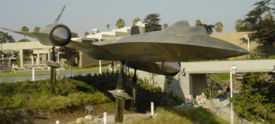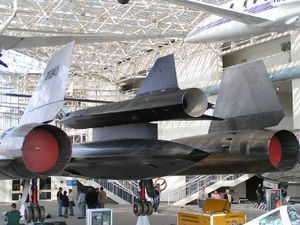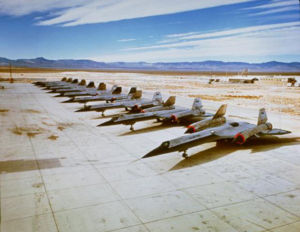PlaneSpottingWorld welcomes all new members! Please gives your ideas at the Terminal.
Lockheed A-12
| A-12 | |
|---|---|
| The only two-seat trainer A-12 ever built carried the nickname "Titanium Goose." On display at the California Museum of Science and Industry, Los Angeles, California | |
| Type | High-altitude reconnaissance aircraft |
| Manufacturer | Lockheed Corporation |
| Maiden flight | 1962 |
| Retired | 1968 |
| Status | In museums |
| Primary user | Central Intelligence Agency |
| Number built | 18 |
| Variants | Lockheed YF-12 SR-71 Blackbird |
The Lockheed A-12 was a reconnaissance aircraft built for the Central Intelligence Agency by Lockheed's famed Skunk Works, based on the designs of Clarence "Kelly" Johnson. The A-12 was produced from 1962 through 1964, and was in operation from 1963 until 1968. The single-seat design, which first flew in April 1962, was the precursor to both the Air Force YF-12 interceptor and the famous SR-71 Blackbird reconnaissance aircraft. The final A-12 mission was flown in May 1968, and the program and aircraft retired in June of that year.
As preliminary work began inside Lockheed in the late 1950s, to develop the successor to the U-2, the designs were nicknamed "Archangel", after the U-2 program, which had been known as "Angel". As the aircraft designs evolved and configuration changes occurred the internal Lockheed designation changed from Archangel-1 to Archangel-2, and so on. These nicknames for the evolving designs soon simply became known as "A-1", "A-2", etc. [1] The A-12 was Lockheed's 12th design in this development of the U-2 successor. However, many documents, and references to individual craft, use Johnson's preferred name for the plane, "the Article".
After selection by the CIA in 1959, further design and production of the A-12 took place under the code-name OXCART.
The first A-12 flight, an aircraft identified as 'Article 121', took place at Groom Lake, Nevada, on April 25, 1962.
Contents
History
In 1959 the CIA selected Lockheed's A-12 over a Convair proposal called KINGFISH. On January 26, 1960, the CIA ordered twelve A-12 aircraft .
After development and production at the Skunk Works, in Burbank, California, the first A-12 was transferred to Groom Lake test facility, where on April 26, 1962, Lockheed test pilot Lou Schalk took the A-12 on its shakedown flight. The first official flight occurred on 30 April. On its first supersonic flight, in early May, 1962, the A-12 reached speeds of Mach 1.1. On October 5 1962, with the newly developed J58 engines, the A-12 flew with one J75 engine, and one J58 engine. By early 1963, the A-12 was flying with J58 engines, and during 1963 these J58-equipped A-12s obtained speeds of Mach 3.2. Also, in 1963, the program experienced its first Blackbird loss when, on May 24, an A-12 crashed near Wendover, Utah. In June of 1964, the last A-12 was delivered to Groom Lake.
On December 28 1966, the decision was made to terminate A-12 operations by 1 June 1968.
In May of 1967, A-12s were flown to Kadena Air Base on Okinawa, Japan and the BLACK SHIELD unit was declared operational. May of 1967 saw the first flight of the A-12 in a surveillance mission over North Vietnam. In February of 1968, in preparation for the replacement of the A-12 by the SR-71, Lockheed was ordered to destroy all tooling used to create the A-12 Blackbirds. Also during this year, the first SR-71 arrived at Kadena to replace the A-12s. On May 8, over North Korea, the last operational mission of an A-12 was undertaken. Subsequently, all deployed A-12s were sent back to Palmdale, California, where they joined the remainder of the A-12 fleet, and all were placed in storage.
Deployments
The A-12s were deployed operationally by the CIA in Operation Black Shield to Kadena AB, Okinawa, Japan, with the first A-12 arriving on May 22 1967. With the arrival of two more aircraft (May 24, and May 27) the unit was declared operational on May 30, and began operations on May 31. [2]
Mel Vojvodich flew the first Black Shield operation, over North Vietnam, photographing Surface-to-Air Missile (SAM) sites, flying at 80,000 ft, and at Mach 3.1. From Kadena, during 1967, the A-12s conducted 22 operations in support of the Vietnam War. During 1968, Black Shield conducted numerous operations in Vietnam and also supported the Pueblo Crisis. On May 8, Jack Layton flew the final mission of the A-12s, after which they were retired from active service and replaced by the SR-71. In the just over one year duration of Operation Black Shield, the A-12s flew 29 operational sorties. On June 4, shortly after operations ceased, and just two-and-a-half weeks before the retirement of the entire A-12 fleet, an A-12 out of Kadena, piloted by Jack Weeks, was lost over the Pacific Ocean near the Philippines while conducting a functional check flight after the replacement of one of the craft's engines.
During its deployment on Okinawa, the A-12s (and later the SR-71) and by extension their pilots, were nicknamed Habu after a cobra-like Okinawan pit viper which the locals thought the plane resembled.
On June 21, pilot Frank Murray took the final A-12 flight, to Palmdale, California.
Timeline
The following timeline describes the overlap of the development and operation of the A-12, and the evolution of its successor, the SR-71.
- December 24, 1957: First J-58 engine run.
- September 14, 1959: CIA awards antiradar study, aerodynamic structural tests, and engineering designs, selecting Lockheed's A-12 over rival Convair's KINGFISH. Project OXCART established.
- January 26, 1960: CIA orders 12 A-12 aircraft
- May 1, 1960: Francis Gary Powers is shot down in a U-2 over the Soviet Union.
- April 26, 1962: First flight of A-12.
- June 13, 1962: SR-71 mock-up reviewed by Air Force.
- July 30, 1962: J58 engine completes pre-flight testing.
- October, 1962: A-12s first flown with J58 engines
- December 28, 1962: Lockheed signs contract to build six SR-71 aircraft.
- January, 1963: A-12 fleet operating with J58 engines
- May 24, 1963: Loss of first A-12 (#60-6926)
- June, 1964: Last production A-12 delivered to Groom Lake.
- July 25, 1964: President Johnson makes public announcement of SR-71.
- October 29, 1964: SR-71 prototype (#61-7950) delivered to Palmdale.
- December 22, 1964: First flight of the SR-71 with Lockheed test pilot Bob Gilliland at AF Plant #42.
- December 28, 1966: Decision to terminate A-12 program by June 1968.
- May 31, 1967: A-12s conduct Black Sheild operations out of Kadena
- November 3, 1967: A-12 and SR-71 conduct a reconnaissance fly-off. Results were questionable.
- January 23, 1968: Seizure of USS Pueblo
- February 5, 1968: Lockheed ordered to destroy A-12, YF-12, and SR-71 tooling.
- March 8, 1968: First SR-71A (#61-7978) arrives at Kadena AB (OL 8) to replace A-12s.
- March 21, 1968: First SR-71 (#61-7976) operational mission flown from Kadena AB over Vietnam.
- May 8, 1968: Jack Layton flies last operational A-12 sortie, over North Korea.
- June 5, 1968: Loss of last A-12 (#60-6932)
- June 21, 1968: Final A-12 flight to Plamdale, California.
For the continuation of the OXCART timeline, covering the duration of operational life for the SR-71, see SR-71 timeline.
Production
A total of 18 aircraft were built through the A-12 program production run. Of these, 13 were A-12s, three were YF-12A interceptors for the Air Force (not funded under the OXCART program), and two were M-21s. One of the 13 A-12s was a dedicated trainer aircraft with a second, higher seat.
The A-12s were designed for direct overflight operations, and consequently optimized for altitude and speed. The first five A-12s, in 1962, were initially flown with Pratt & Whitney J75 engines capable of 17,000 lbf thrust each, enabling the J75-equipped A-12s to obtain speeds of approximately Mach 2.0. In 1963, after overcoming initial development challenges, the more powerful 31,500 lbf thrust (and later 34,500 lbf) [3] Pratt & Whitney J58 engines became available. The Pratt & Whitney J58 engines enabled the A-12 to reach speeds of approximately Mach 3.2. From 1963 onward, the A-12s used the J58 engine, with the exception of the A-12 trainer "Titanium Goose", which retained the J75 powerplants for its entire service life.
In 1960 the Air Force approved funding for the conversion of three A-12 production units into two-seat interceptor aircraft capable of Mach 3 speeds. This A-12 variant was designated the YF-12. The program, while successful, never entered full production, and the YF-12 was further redesigned into the famous SR-71 Blackbird. Outwardly quite similar to the original A-12s, the SR-71 was longer by 5.05 feet, had a sensor payload that was 1,500 lb. heavier, and a second crew member who operated the reconnaissance equipment and cameras.
Another A-12 variant, the M-21, was configured as a platform for launching the D-21, a Mach 3+ reconnaissance drone that began development in October 1962. Two M-21s were produced for this purpose. Originally known by the Lockheed designation Q-12, the D-21 was intended to be launched off the back of the M-21 for extra-long range flights and/or missions that were too dangerous for a manned vehicle. The program was cancelled when the second conversion model M-21 crashed, killing a Lockheed test crewman.
Five A-12s, two of the YF-12s, and one of the M-21s were destroyed in flight testing and other accidents.
| Serial number | Model | Location or fate |
|---|---|---|
| 60-6924 | A-12 | Blackbird Airpark, Palmdale, CA |
| 60-6925 | A-12 | Intrepid Sea-Air-Space Museum, New York City, NY |
| 60-6926 | A-12 | Lost, 24 May 1963 |
| 60-6927 | A-12 | California Museum of Science and Industry in Los Angeles, CA ("Titanium Goose" trainer) |
| 60-6928 | A-12 | Lost, 5 January 1967 |
| 60-6929 | A-12 | Lost, 28 December 1967 |
| 60-6930 | A-12 | Alabama Space and Rocket Center, Huntsville, Alabama |
| 60-6931 | A-12 | CIA Headquarters, Langley, Virginia |
| 60-6932 | A-12 | Lost, 5 June 1968 |
| 60-6933 | A-12 | San Diego Aerospace Museum, Balboa Park, San Diego, CA |
| 60-6934 | YF-12A | Transformed into SR-71C 64-17981 after fire damage in 1966 |
| 60-6935 | YF-12A | U.S. Air Force Museum, Wright-Patterson AFB, OH |
| 60-6936 | YF-12A | Lost, 24 June 1971 |
| 60-6937 | A-12 | Southern Museum of Flight in Birmingham, Alabama. |
| 60-6938 | A-12 | U.S.S. Alabama Battleship Museum, Mobile, AL |
| 60-6939 | A-12 | Lost, 9 July 1964 |
| 60-6940 | M-21 | Museum of Flight, Seattle, WA |
| 60-6941 | M-21 | Lost, 30 July 1966 |
Variants
M-21/D-21
One notable variant of the basic A-12 design was the M-21, used to carry and launch the D-21 drone, an unmanned, faster and higher-flying reconnaissance craft. The M-21 was an A-12 platform modified by replacing the single-seat aircraft's Q bay (which carried its main camera) with a second cockpit for a launch control officer. When mated to the drone for operations, this A-12 variant was known as the M/D-21. The D-21 drone was completely autonomous; having been launched it would overfly the target, travel to a pre-determined rendezvous point and eject its data package. The package would be recovered in midair by a C-130 Hercules and the drone would self-destruct.
The program to develop this system was canceled in 1966 after a drone collided with the mother ship at launch, destroying the M-21 and killing the Launch Control Officer. Three successful test flights had been conducted under a different flight regime; the fourth test was in level flight, considered an operational likelihood. The shock wave of the M-21 retarded the flight of the drone, which crashed into the tailplane. The crew survived the mid-air collision but the LCO drowned when he landed in the ocean and his flight suit filled with water.
The M/D-21 performed operational missions over China in 1970 and 1971.
The surviving M-21 is on display at the Museum of Flight in Seattle, Washington with a drone. The D-21 was adapted to be carried on wings of the B-52 bomber.
YF-12A
The YF-12 program was a limited production variant of the A-12 OXCART spy plane designed for the CIA and first flown in 1962. Lockheed was able to convince the U.S. Air Force that an aircraft based on the A-12 would provide a less costly alternative to the recently cancelled North American Aviation XF-108, since much of the design and development work on the YF-12 had already been done and paid for. Thus, in 1960 the Air Force agreed to take the 11th through 13th slots on the A-12 production line and have them completed in the YF-12A interceptor configuration.
The main changes involved modifying the aircraft's nose to accommodate the Hughes AN/ASG-18 fire-control radar originally developed for the XF-108, and the addition of a second cockpit for a crewmember to operate the fire control radar. The nose modifications changed the aircraft's aerodynamics enough to require ventral fins to be mounted under the fuselage and engine nacelles to maintain stability. Finally, bays previously used to house the A-12's reconnaissance equipment were converted to carry missiles.
Retirement
Nearly a decade passed between the original conception of the OXCART program and the operational use of the A-12. After just 29 operational sorties, the A-12 were retired. At their retirement, in 1968, the eight non-deployed aircraft were placed in storage. The deployed A-12s returned from Japan to Palmdale, California and were also placed in storage. All surviving aircraft remained there for nearly twenty years before being sent to museums around the United States. On January 20 2007, after a bitter fight between Minnesota's government and the US Air Force, the A-12 preserved in Minneapolis, Minnesota, was dismantled to ship to CIA Headquarters to be displayed there. [4]
A-12 aircraft on display
The eight A-12's which remain in existence are lcoated at the:
- U.S. Space and Rocket Center, Huntsville, Alabama
- Battleship Memorial Park, Mobile, Alabama
- Southern Museum of Flight, Birmingham, Alabama
- Intrepid Sea-Air-Space Museum, parked on the deck of the USS Intrepid (CV-11) aircraft carrier, New York City
- San Diego Aerospace Museum, San Diego, California
- Air Force Flight Test Center Museum, Blackbird Airpark, at Edwards Air Force Base, Palmdale, California (60-6924, the first A-12 to fly, on April 26 1962)
- California Museum of Science and Industry, Los Angeles, California, California
- one is currently being shipped to Langley, Virginia to be placed on exhibit on the grounds of the Central Intelligence Agency (formerly located in at the Air National Guard, Minneapolis, Minnesota)
The sole remaining M/21 variant is located at:
The sole remaining YF-12A is located at:
Specifications (A-12)
General characteristics
- Crew: 1-2
- Length: 102 ft 3 in (31.26 m)
- Wingspan: 55 ft 7 in (16.97 m)
- Height: 18 ft 6 in (5.64 m)
- Wing area: 1,795 ft² (170 m²)
- Empty weight: 67,500 lb (30,600 kg)
- Loaded weight: 117,000 lb (53,000 kg)
- Max takeoff weight: lb (kg)
- Powerplant: 2× Pratt & Whitney J58-1 continuous bleed-afterburning turbojets, 32,500 lbf (144.57 kN) each
- * Payload: 2,500 lb (1,100 kg) of reconnaissance sensors
Performance
- Maximum speed: Mach 3.35 (2200 mph, 3500 km/h) at 75,000 ft (23,000 m)
- Range: 2,200 nm (2,500 mi, 4,000 km)
- Service ceiling: 95,000 ft (29,000 m)
- Rate of climb: 11,800 ft/min (60 m/s)
- Wing loading: 65 lb/ft² (320 kg/m²)
- Thrust/weight: 0.56
Notes and references
- ↑ The U-2's Intended Successor: Project Oxcart 1956-1968, approved for release by the CIA in October, 1994 - accessed January 26 2007
- ↑ McIninch, Thomas (July 2 1996). The OXCART Story. CIA.gov. Retrieved on January 26 2007 {{{accessyear}}}.
- ↑ Lockheed Martin web site - SR-71 Blackbird
- ↑ Karp, Jonathan. "Stealthy Maneuver: The CIA Captures An A-12 Blackbird", The Wall Street Journal, January 26, 2007, p. A1.
External links
- A-12T Exhibit at California Science Center
- Differences between the A-12 and SR-71
- Blackbird Spotting maps the location of every existing Blackbird, with aerial photos from Google Maps
- Photographs and disposition of the "Habu" aircraft at www.habu.org
- The Oxcart Story Approved For Release 1994, CIA Historical Review Program
- The U-2's Intended Successor: Project Oxcart (Chapter 6 of "The CIA and Overhead Reconnaissance," by Pedlow & Welzenbach)
- The Hunt for 928
- USAF Aircraft Serial Numbers for 1960, including all A-12s, YF-12As, and M-21s
- USAF Aircraft Serial Numbers for 1961, including all SR-71s
Related content
Related development
Related lists
- List of military aircraft of the United States
- List of Lockheed aircraft
- List of reconnaissance aircraft
See also
Airliners and Civil Transports: Vega · Electra · Electra Junior · Super Electra · Lodestar · Constellation · Saturn · L-188 Electra · L-402 · JetStar · L-1011 TriStar
Military Transports : C-64 · C-121 · R6V · C-130 Hercules · C-141 Starlifter · C-5 Galaxy
Fighters: F-22 Raptor · F-35 Lightning II · F-94 Starfire · F-104 Starfighter · F-117 Nighthawk · P-38 Lightning · P-80 Shooting Star · T-33 Shooting Star
Patrol and reconnaissance : Hudson · PV-1 Ventura · PV-2 Harpoon · P-2 Neptune · P-3 Orion · CP-140 Aurora/CP-140A Arcturus · U-2 · SR-71 Blackbird · S-3 Viking
Lists relating to aviation | |
|---|---|
| General | Timeline of aviation · Aircraft · Aircraft manufacturers · Aircraft engines · Aircraft engine manufacturers · Airports · Airlines |
| Military | Air forces · Aircraft weapons · Missiles · Unmanned aerial vehicles (UAVs) · Experimental aircraft |
| Notable incidents and accidents | Military aviation · Airliners · General aviation · Famous aviation-related deaths |
| Records | Flight airspeed record · Flight distance record · Flight altitude record · Flight endurance record · Most produced aircraft |
cs:Lockheed A-12 es:Lockheed A-12 OXCART fr:A-12 Oxcart pt:A-12 OXCART



